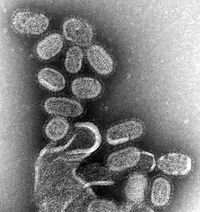
Photo from wikipedia
Actively shedding healthy horses have been indicated as a possible source of respiratory pathogen outbreak, transmission, and spread. Using nasal swabs from clinically healthy sport horses submitted for qPCR testing… Click to show full abstract
Actively shedding healthy horses have been indicated as a possible source of respiratory pathogen outbreak, transmission, and spread. Using nasal swabs from clinically healthy sport horses submitted for qPCR testing after an outbreak of equine herpesvirus-1 (EHV-1) myeloencephalopathy (EHM) in the spring of 2022, this study aimed to identify the rate of clinically healthy horses shedding common and less characterized respiratory pathogens within the sport horse population to better understand their role in outbreaks. Swabs were collected during a required quarantine and testing period, according to the United States Equestrian Federation (USEF), and showed return-to-competition requirements. Common respiratory pathogens, such as equine influenza virus (EIV), EHV-4, and equine rhinitis B virus (ERBV), were found at low but stable frequencies within previously reported ranges, whereas EHV-1 and Streptococcus equi subspecies equi (S. equi) were found at or above previously reported frequencies. Less characterized respiratory pathogens, such as EHV-2, EHV-5, and S. equi subspecies zooepidemicus (S. zooepidemicus), were found within previously reported ranges. Common respiratory pathogens, especially EHV-1 following the multiple EHM outbreaks, were found to be circulating in clinically healthy sport horse populations, reflecting their silent transmission. The strategy of quarantine and EHV-1 qPCR testing of clinically healthy horses was successful at eliminating additional EHM outbreaks and facilitating safe return to competition with no reported respiratory disease outbreaks following the subsequent shows in California.
Journal Title: Pathogens
Year Published: 2022
Link to full text (if available)
Share on Social Media: Sign Up to like & get
recommendations!